by Winding Pathways | Oct 1, 2020 | (Sub)Urban Homesteading, Birds, Mammals, Nature
We’ll remember August 10, 2020, forever. On that day the wind changed Eastern Iowa and Winding Pathways in a way that will persist for a century. In 40 minutes, straight-line wind gusts up to 140 miles an hour toppled or broke 47 of our 53 trees. Two landed on our roof.
Our property adjoins Faulkes Heritage Woods, a 110-acre preserve of tall old trees, mostly oaks. The derecho felled most of its big trees that tumbled into a jumbled mass of trunks, branches, and leaves.
-
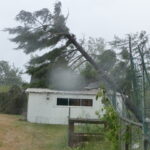
-
The pine toppled onto the cabin roof.
-
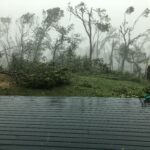
-
Effects of straight-line winds.
-
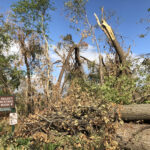
-
Twisted trees.
Wondering how the great change would impact wildlife, we quickly noticed two short term impacts. August and September are usually slow months for bird feeder visitors as birds normally have plenty of wild food. As soon as the wind calmed, all was still. Faithfully, Rich found and filled the feeders. The next morning, we noticed heavy use by house finches, titmice, nuthatches, cardinals, woodpeckers, and chickadees. It was almost like the feeding frenzy that happens as a winter blizzard approaches.
Short Term Impacts
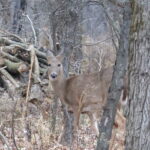
Trails are disrupted.
We quickly realized that deer, raccoons, coyotes, woodchucks, squirrels, and even chipmunks experienced a life-changing event. Their travel corridors changed as huge trees blocked deer trails, for example. They had to find new routes through the debris. One afternoon we saw a mother deer and fawn walking on the one remaining “open” trail around our prairie. Then, they crawled under a fallen tree and disappeared into the maze of branches. The ever clever raccoons have become more than pests as they tear up feeders and raid garbage cans. Also, the storm destroyed this year’s acorn and walnut crop, nuts that many species require. That is why the birds came so readily to the feeders. And still do!
-

-
The house finches eat serenely.
-

-
Even the crows come around to grab a snack.
-
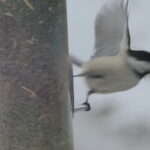
-
From early light to last dusk chickadees work the feeders.
Longer-Term Impacts
We are now watching for the long term impacts of the loss of so many trees. Our good friend, Jim Berry, is the former executive director of the Roger Tory Peterson Institute in New York. We asked him what we might expect following the loss of so many big trees in Faulkes Woods and our property.
“There are winners and losers. I would expect to see fewer wood thrushes, ovenbirds, and scarlet tanagers. They prefer mature forests. The more open woods and sunshine hitting the ground will cause an increase in cardinals, robins, and white-eyed vireos,” he said.
We have been fortunate to enjoy seven woodpecker species over the years. Some will benefit and some will lose from the great woods opening windstorm. According to Jim red-headed, red-bellied, and downy woodpeckers are likely to increase. So will flickers.
But sapsuckers and hairy and pileated woodpeckers that like the old trees and a closed canopy will probably decline.
-
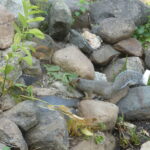
-
The small mammals are hungry.
-
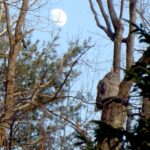
-
Owls will benefit from broken trees as cavities develop.
-
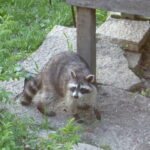
-
Raccoons ravage feeders at night.
The loss of hollow trees that shelter animals and the destroyed nut crop are going to make this a lean winter for squirrels. Deer, blue jays, woodchucks, chipmunks, and wild turkeys will also miss the acorns that normally rain down each fall.
We were saddened to lose so many trees but look forward to watching the forest restore itself. We’re also watching to see changes in wildlife.
by Winding Pathways | Sep 24, 2020 | (Sub)Urban Homesteading, Garden/Yard, Mammals, Nature
People in Eastern Iowa planting young trees to replace those shattered by the August 10 Derecho need to remember an important step. Protect those vulnerable and valuable young trees.
Here is our story. A distressing sight greeted us one September morning a few years ago as we walked to the mailbox to get the newspaper. Overnight a deer had chosen our favorite young maple tree to polish his antlers. He was thorough and had rubbed the bark off all around the two-inch diameter trunk. It was girdled and doomed.
We should have known better. Buck deer start growing their antlers in April and by about Labor Day, they are full size. Antlers are formed by a blood-rich skin called velvet. By late summer it has dried and bucks rub it off polishing up their antlers for dominance battles with rivals. By neglecting to protect our tree we gave a buck a great rubbing place. And doomed our tree to an early death.
Deer begin rubbing in early fall and sometimes continue until the deer mating season approaches in early November. Deer live in most American cities and regularly roam through suburbs. They are as happy to rub their antlers on an ornamental tree in the front yard as on one back in the woods. It’s never good for the tree.
Deer seem to prefer to rub on saplings with trunks a few inches in diameter. They especially seem to prefer pine and black cherry trees but we have even lost young spruces to their rubs. One thing is predictable. The tree that a family most treasures is the one a buck is likely to destroy.
Damage is preventable. We now run a four-foot-high circle of wire mesh around the tree and wire it to a fence post hammered securely into the ground. Once a tree reaches five or six inches in diameter deer rarely bother them, so the wire is only needed for a few years.
Be sure to water your new, young fall-planted tree. And, protect it with wire mesh.
-
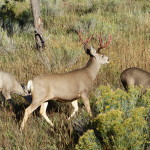
-
With polished antlers, this muledeer buck proudly strode across the meadow. Whitetails are more common in the East and Midwest. “Mulies” are common in the High Plains and west.
-
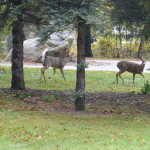
-
On Halloween day a buck was hot on the “tail” of this doe and yearling.
-
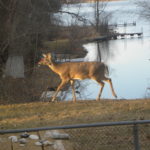
-
Deer in yard.
by Winding Pathways | Jul 16, 2020 | Garden/Yard, Mammals, Pests
What to Do About Raccoons
One June morning we peered out our dining room window to see bird feeder carnage. The shepherd’s hook that holds up suet and seed feeders were bent and the board it was anchored in shattered. The feeders were gone. One we later found in the little pond we have. We were frustrated and a bit angry.
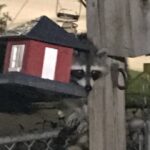
Raccoons are skillful climbers. (Jill photo)
Raccoons were the culprits. Several had raided the night before. Young raccoons are loved everywhere for their “cuteness”. We like them too, but damage can’t be ignored, so we took action.
Amazing Animals
Raccoons are amazingly successful animals. They live nearly everywhere in the continental United States and southern Canada. A few years ago, our son sent us a photo he snapped of a raccoon in a dumpster in our nation’s largest city. They thrive in urban, suburban, and rural areas, especially those that have streams, rivers, or lakes nearby and denning places. Those could be hollow trees, road culverts, or even barns, garages, and house attics.
Raccoons were released in Russia and Japan, where they thrive and are expanding their range. Away from North America they are an invasive species causing ecological problems and probably raiding chicken coops and bird feeders in their new countries.
What do Raccoons Eat?
They are successful, in part, because of their eclectic diet. True omnivores, raccoons enjoy dining on carrion, frogs, crayfish, mice, dog and cat food, birdseed, fruit, and a host of other things, even human food scraps tossed in trash cans.
How We Foil the Raccoons
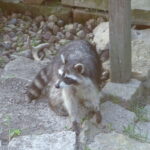
Raccoons forage wherever they find food.
We don’t want to physically harm the raccoons that damaged our bird feeding station so we are doing these things:
- Only put out as much seed as birds eat during the day, so night prowling raccoons find none to munch on. They move on.
- Bring silo, suet and hummingbird feeders inside each evening, so they’re not out to temp nocturnal animals.
- We don’t have a cat or dog but if we did, we would keep their food inside where raccoons cannot get to it.
- We close the sturdy doors that keep raccoons out of our chicken house at night. We’ve also installed heavy wire mesh over the coop’s windows.
- We feed food scraps to our chickens and compost what the hens won’t eat in a “tight” compost bin that raccoons can’t enter. Fortunately, chickens devour the foods raccoons love and shun foods that raccoons also don’t eat. If we had to put food scraps in the garbage, we’d keep the can in the garage where wildlife can’t access it.
Capturing the Culprit
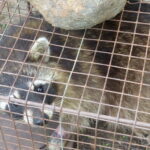
This raccoon readily entered the box trap to eat the sardines.
The night after the raccoons ruined our feeders, we did one other thing. We have a metal box trap that catches, but doesn’t harm, animals. We set it near the feeder with a sardine for bait. A big raccoon went right in. We let him stay there for a while so he could ponder his captivity. Then we sprayed him with water from the hose and opened the trap. He zoomed out like greased lightning, but he may have enjoyed the stay. It was a hot night and the hose water probably cooled him down. We hope he remembers being confined for a short while and stays away.
So far, these actions have worked. Our chickens are healthy and safe. And, no damage to feeders will happen when raccoons prowl.
by Winding Pathways | Apr 23, 2020 | Mammals, Nature, Reflections/Profiles, Uncategorized, Wonderment
A few months ago, we posted a blog honoring Smokey Bear on his 75th birthday. Smokey was created by the United States Forest Service in an effort to encourage people to be careful with fire. His was one of the most successful marketing campaigns in history.
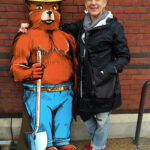
The allure of Smokey Bear.
Smokey is adorable yet commanding. When he said to drown campfires and snuff out cigarettes you did it without question. Today, we know that forest fires are a natural phenomenon with beneficial ecological impacts, but Smokey’s message still resonates.
Two Winding Pathways readers shared their memories of Smokey Bear.
Tracy McPartland of Cedar Rapids sent us a photo of her with Smokey taken at the Smithsonian. “I loved Smokey Bear as a kid. I used to voice imitate him even though I don’t know what his voice was like.”
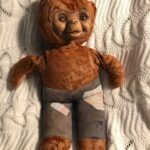
Smokey has been well-loved.
Jim Rainey is a retired US Army LTC who lives in Pennsylvania. Recently, he told us he received a Smokey doll from Santa in the early 1950s when he was four or five years old. “I was enchanted by Smokey. And, my doll still sits on the chair in my office. Sometimes my dog uses him as a pillow. At age 65, or so, he has patches on his jeans, is missing some hair, and part of his nose is gone. A few years ago, we asked our three daughters what they wanted of our stuff and was surprised when our oldest daughter said she wanted Smokey. Before then I was thinking of having him put in my casket, but I really didn’t want him locked in a box for eternity. I’ll let my daughter enjoy him and think of me,” he said.
Rich also has pleasant memories of Smokey and passed his image whenever he entered the Boise, Clearwater, or Idaho Panhandle National Forests during his college years. In 1974 he was a US Forest Service Hot Shot and fought three wildfires in Idaho. He’s kept a Smokey poster on his office wall for years.
There is confusion. Technically he’s Smokey Bear, not Smokey THE Bear.
A former college contact, the Fazio Family, owns Woodland Catalog Smokey Bear Gifts and has a store in Moscow, Idaho. Anyone wanting Smokey items can order it online. There’s a Smokey Bear museum in a state park in Capitan, New Mexico. You can take a brief virtual tour at
Smokey endures for the ages. His message is clear, and his presence is endearing.
by Winding Pathways | Feb 13, 2020 | Birds, Mammals, Nature
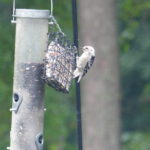
This Albino Woodpecker comes to the feeder regularly.
Several months ago, we looked out our dining room window and saw an unusual woodpecker enjoying suet at a feeder only a few feet away. It was a downy but it’s head was almost completely white, unlike all others of the same species we’ve seen.
Last year we had a fox squirrel with an unusually short tail that hung around our yard for months. We’ve also spotted other wild animals with distinctive markings unusual for their species, healed but visible wounds and other characteristics that help identify it as an individual.
The Power of Observation
Being able to identify an individual animal adds to the fun of wildlife observation. For example, from the squirrel, we learned that he or she mostly just stayed in our yard and nearby woods. We never spotted it at a neighbor’s yard. Then, one day we remarked, “We haven’t seen’ shorty tail’ for a while”. We actually never saw the animal again and assumed he or she met his end due to an accident, predator, car collision, or some other catastrophic incident. Because we could tell him from other squirrels, we know he lived at least ten months.
The piebald woodpecker still comes to our feeder, and we’re getting to know it as an individual rather than just a generic downy. It adds to the fun of wildlife observation.
Like people, animals are individuals. At first glance, every one may look the same but with careful observation, it’s possible to spot differences in plumage, fur, size, shape, gait, and even personality that help identify it as an individual. Scientists studying animals ranging from whales to snow leopards often learn to distinguish one from another by the pattern of barnacles on a whale’s body to the markings on a cat’s fur.
It’s a totally noninvasive way of distinguishing one from another. We can do this with common yard wild animals.
Do Squirrels Ever Fall?
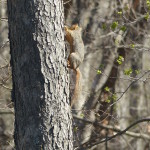
What happens when a squirrel falls?
Squirrels are amazingly agile, but they do slip and fall. It’s not common, but it happens. Rich has seen two squirrels fall from the top of large oak trees.
One squirrel lost its footing on a huge oak tree at the Indian Creek Nature Center when Rich was walking nearby. It spread out its legs and tail and fell horizontally, hitting the ground with a “thump”. Although it fell at least 40 feet the squirrel appeared uninjured, scampered off, and climbed right back up the oak.
Another squirrel fell from an even bigger oak in our home’s backyard. It did the same as the Nature Center Squirrel and spread out its body, hit the ground, and ran right off.
Squirrels rarely fall, but once in a while, they do. Fortunately, as this YouTube video shows, they seem amazingly able to recover from a fall that would instantly kill a human.
What are some of the animals you know as individuals? Let us know!
by Winding Pathways | Feb 6, 2020 | (Sub)Urban Homesteading, Mammals
One February morning I took a short work break and walked through the woods near a parking lot and a busy road. I wasn’t paying attention to where I was walking until I stepped on a hard-pointy object.
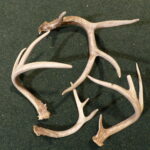
Finding a matching pair is unusual.
It was a huge deer antler that a buck had recently dropped. Finding it made my day and converted me into a shed hunter.
Shed hunting is a fun late winter activity that lets anyone hunt deer without the need to buy a hunting license. It is deer hunting without the need to kill an animal.
What is a deer shed?
All male members of the deer family and caribou females grow a new pair of antlers every year. They’re not horns. Sheep and goats grow horns, which stay on their head for life and are made of the same material as human fingernails. Antlers, in contrast, are bones of mostly calcium. They are the only bones that grow outside the body and are nourished by a blood-rich skin called velvet.
Why do deer drop their antlers?
Bucks begin growing antlers around April in most places. By September they are fully formed. They rub their antlers on trees to remove the no longer needed velvet, and the now polished bones are ready for jousts between males to figure out who’s the boss buck. By Christmas a dropping testosterone level causes the antlers to fall off. These “cast” or “shed” antlers can hit the ground as early as Christmas or as late as early April. But February is a prime time to search for them.
Where can I look for deer sheds?
Obviously, the best place to look for sheds is where deer hang out. Tracks, droppings, and actual deer sightings help locate prime places. In this modern era, some of the biggest bucks live in suburban and urban areas, so it’s possible to saunter out into the backyard and find one. Wooded city parks and timbered wooded corridors are also prime spots. Be sure to have permission before venturing on private land.
-
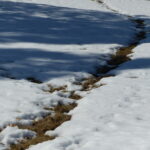
-
Deer walk the same path.
-

-
Sheds can be found where deer rest.
-
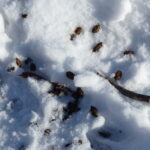
-
Follow trails of deer scat when shed hunting.
There’s more to shed hunting than we’re putting in this short blog. An outstanding resource is SHED HUNTING, A Guide To Finding White-Tailed Deer Antlers by Joe Shead (yup that’s his real name, and it’s pronounced “shed). For information check out www.goshedhunting.com/shop.
























